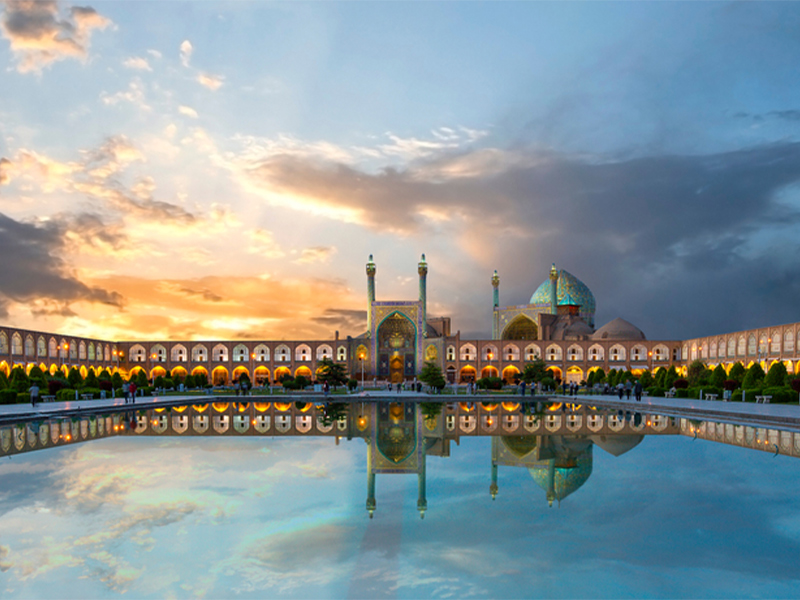Familiarizing yourself with the Isfahan travel guide is one of the most important topics to have an enjoyable trip. This is because Isfahan is one of the central cities of Iran and holds great significance among tourists due to its rich history, tourist attractions, and excellent recreational and accommodation facilities provided for travelers. This city is a major destination for domestic and international tourists and has gained worldwide fame for its UNESCO-listed historical sites and ancient culture, customs, and traditions. Therefore, in this article from Eligasht, we intend to talk about traveling to Isfahan and the necessary information for a trip to half of the world.
Book Iran Air flights from London to Tehran and Tehran to London with Eligasht UK:
Geographical Location of Isfahan
Isfahan province is located in central Iran and is situated approximately 435 kilometers south of Tehran in terms of geographical location. It shares borders with Tehran and Qom to the north, Shiraz and Yasuj to the south, Lorestan and Chaharmahal and Bakhtiari to the west, and Yazd to the east. Isfahan province is composed of 14 urban areas, and the city of Isfahan is one of the major cities in the country and is recognized as the third most populous city in Iran.
The unique historical sites and attractions of Isfahan, known as half of the world, hold great importance due to their rich history. Some of Isfahan’s historical sites have been registered on the UNESCO list, contributing to its global reputation among domestic and international tourists.
Isfahan Travel Guide – Weather in Isfahan
Considering that Isfahan is located in the semi-desert region of Iran, its weather conditions are also influenced by this geographical factor. The northern and eastern regions of the province have a desert climate, and as you move south, you will experience cooler weather.
In general, the climate of Isfahan is moderate and dry, with limited snowfall and rainfall. In the hottest days of summer, the temperature can reach up to 40 degrees Celsius.
With all the information mentioned above, the best time to travel to Isfahan is during the autumn season. However, many tourists also visit Isfahan during this season, which may result in slightly higher costs. If you want to travel to Isfahan during a more budget-friendly time, we recommend winter.
Best Time to Travel to Isfahan
Isfahan province, due to its central and desert location, enjoys suitable and relatively moderate and semi-dry weather throughout the year. You can visit this beautiful city at any time when you have sufficient opportunity to travel. However, the best time to travel to Isfahan is during the spring season. During this season, besides the pleasant and moderate weather, the trees become lush and vibrant, and you won’t have to deal with exhausting heat, allowing you to easily explore Isfahan.
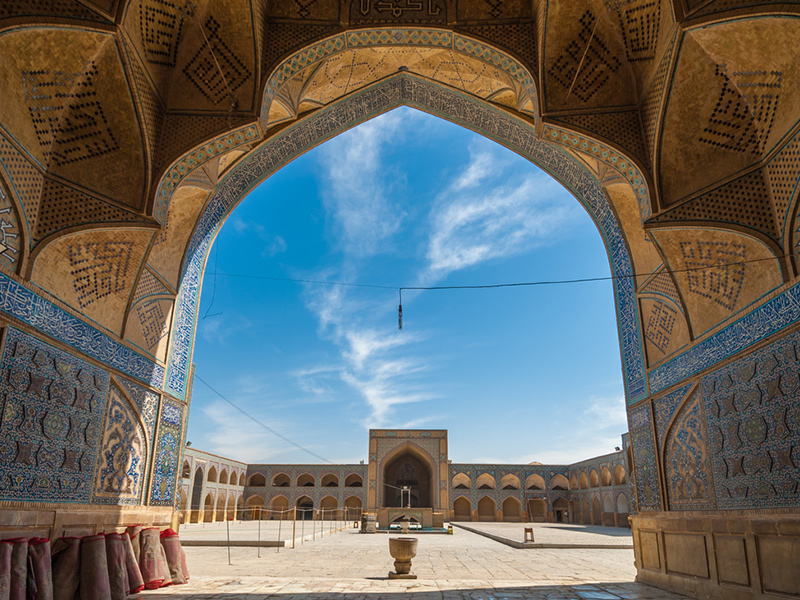
Isfahan Travel Guide – Getting to Isfahan
Traveling by train:
One of the best routes for traveling to Isfahan is by train. Isfahan Railway Station is located near the city and has stations on the routes of Shiraz, Yazd, Tehran, Bandar Abbas, and Mashhad. You can easily travel to Isfahan from these cities by train.
Traveling by airplane:
If you plan to travel to Isfahan by airplane, you can easily reach the city with daily flights from most airports in the country. Isfahan Shahid Beheshti International Airport is located in the Safa region, about 20 kilometers from the city center, and you can easily access the city center via Chamran Highway.
Traveling by road:
Isfahan is centrally located in the country, which allows easy access to the province via various roads. If you are traveling from Tehran to Isfahan, after leaving Tehran, you need to take the Persian Gulf Highway to Kashan and then take the Kashan Expressway towards Isfahan. Additionally, if you are traveling from the south or southwest, the best route is the Shiraz-Isfahan Highway.
Staying in Isfahan
5-Star Hotels
Isfahan is one of the famous tourist destinations in the country, which has led to the construction of numerous luxury hotels in the city. Some of these include the 5-star Abbasi Hotel, Kowsar Hotel, and Attar Hotel.
4-Star Hotels
Among the best 4-star hotels in Isfahan, you can find the Pirouzi Hotel, Aseman Hotel, Ali Ghapoo Hotel, and Safir Hotel.
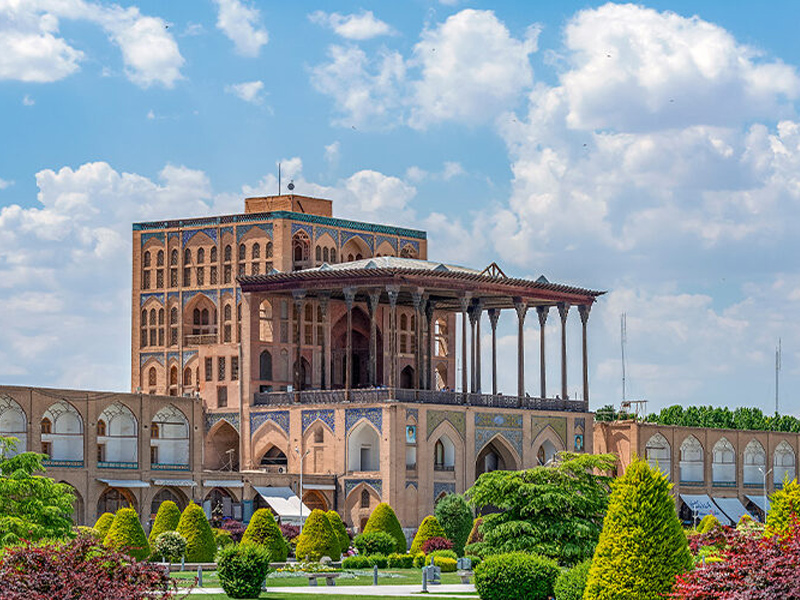
3-Star Hotels
The best 3-star hotels in Isfahan, which offer suitable facilities and affordable prices, include Isfahan 3-star Hotel, Zohreh Hotel, Suite Hotel, Safavi Hotel, Sheikh Bahai Hotel, Khaju Hotel, Baran Hotel, Venus Hotel, Sepahan Hotel, and Setareh Hotel.
Boutique Hotels
One of the best options for accommodation in Isfahan is traditional and historical houses that have now been transformed into luxurious boutique hotels for travelers. Some of them include Sarhang Palace Boutique Hotel, Bekhradi Historical House, Kariz Boutique Hotel, and Kianpour Historical House.
Traditional Hotels
Among the other attractive hotels for staying in historical mansions in Isfahan are the traditional hotels of the city, including Atigh Traditional Hotel, Mansouri Traditional Hotel, and Isfahan Traditional Hotel.
Isfahan Travel Guide – Public Transportation in Isfahan
The public transportation system in Isfahan is one of the diverse networks in the country, allowing easy access to all parts of the city during your trip to Isfahan. Among the public vehicles that you can use in your trip to the half of the world are metro, buses, bicycles, and various types of taxis.
Buses
Buses are one of the old and common public vehicles in Isfahan, which operate in regular and special lines throughout the city. On your trip to Isfahan, you can use these buses to travel to various parts of the city. Isfahan’s buses consist of 176 lines and over 1,600 buses and are considered one of the best bus systems in the country, allowing you to travel to all parts of the city.
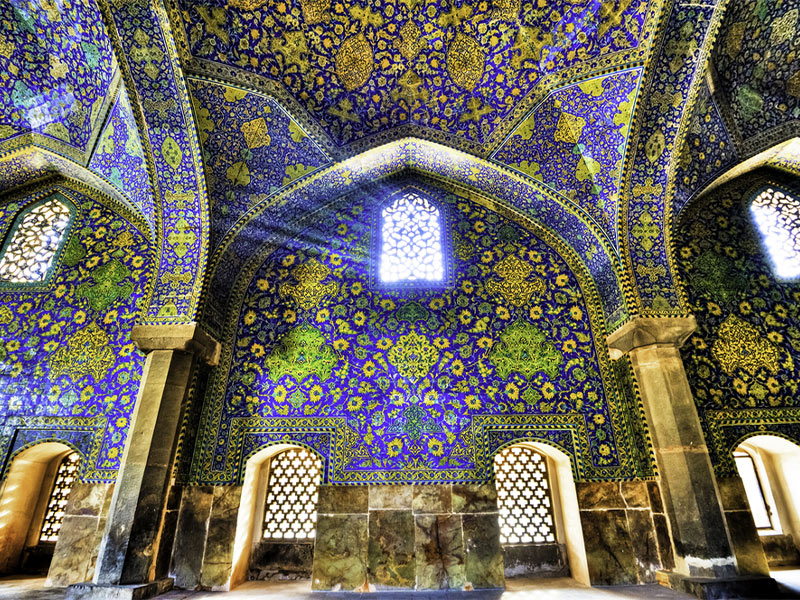
Isfahan Metro
Isfahan Metro is one of the best public transportation vehicles in Isfahan, which can take you to your destination in the shortest possible time. Isfahan Metro currently operates only one line from north to south of Isfahan. It starts from Defa’e Moghaddas Station and ends at Ghods Square. You can walk to the nearby historical attractions from the stations it passes by.
Taxi
If you intend to travel within the city personally and want to reach your destination in a short time, the best way is to use a taxi. In Isfahan, like other cities in the country, various types of taxis such as online taxis, telephone taxis, wireless taxis, and tourist taxis are available.
Bicycle Rental
One of the best options for city sightseeing in Isfahan is bicycle rental. You can rent a bicycle from bicycle stations located throughout the city by providing the required identification documents and paying the specified fee for a certain period. After the time is up, you can return the bicycle to the same station.
Isfahan Travel Guide – Exploring Isfahan’s Cuisine
One of the enjoyable and delicious parts of traveling is trying the local and famous foods of the destination. Like other cities in Iran, Isfahan has its own culinary culture and offers a variety of authentic and traditional dishes that are worth trying during your trip to Isfahan. Some of the famous and delicious dishes in Isfahan that this Isfahan travel guide recommends you try while visiting Isfahan are Biryani, Halim Bademjan, Gheimeh Rizeh, Khoresht Mast, Kaleh Joosh, Gooshto Lubia, and Gooshto Nokhod-e Esfahani.
Best Restaurants in Isfahan
Among the places that tourists visit for food during their trip to Isfahan are Isfahan’s restaurants. Some of the best restaurants in Isfahan include Shahrzad Restaurant on Chaharbagh Abbasi Street, Khan Gostar Restaurant with three branches in Jolfa Hotel Lobby, Atashgah Street, and City Center, Jar-chi Bashi Restaurant on Sepah Street, Haj Mahmoud Biryani in Isfahan Grand Bazaar, and Hermes Café Restaurant in Jolfa neighborhood. These restaurants are considered among the best in Isfahan due to their delicious and traditional food as well as their beautiful architecture and suitable facilities.
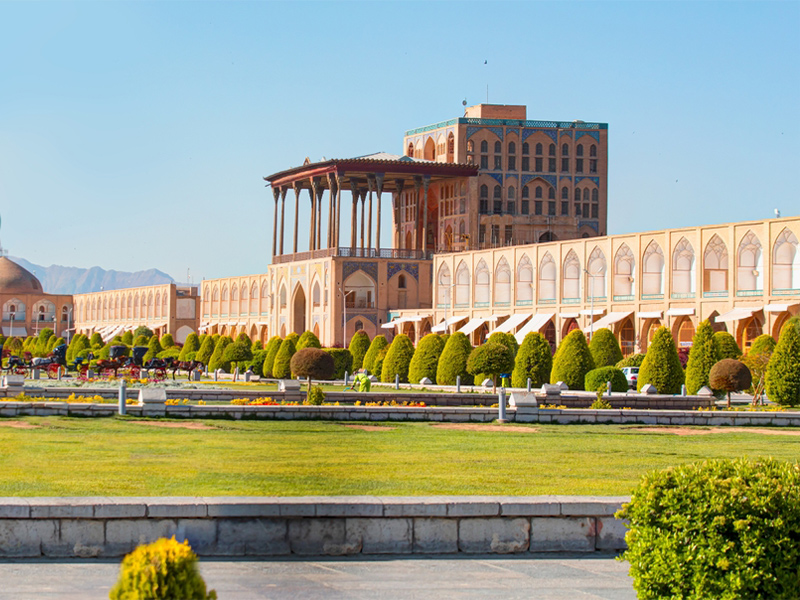
Isfahan Travel Guide – Top Attractions in Isfahan
Isfahan is home to remarkable historical and cultural attractions, many of which date back to the Safavid era. Some of the must-visit attractions in Isfahan include:
- Naqsh-e Jahan Square: A UNESCO World Heritage site and one of the largest squares in the world.
- Imam Mosque: A stunning masterpiece of Islamic architecture located on Naqsh-e Jahan Square.
- Sheikh Lotfollah Mosque: Known for its intricate tile work and mesmerizing dome.
- Ali Qapu Palace: A grand palace with beautiful architectural features and a stunning view of the square.
- Chehel Sotoun Palace: A palace with a beautiful pavilion and mirrored halls surrounded by a Persian garden.
- Si-o-se Pol Bridge: The iconic bridge spanning the Zayandeh-rood River with 33 arches.
- Vank Cathedral: A historic Armenian church known for its exquisite frescoes and artwork.
- Jameh Mosque of Isfahan: A UNESCO-listed Friday mosque with a long history and beautiful architecture.
- Hasht Behesht Palace: A magnificent palace known for its intricate tilework and stunning gardens.
- Isfahan Bazaar: A bustling traditional market with shops selling handicrafts, carpets, spices, and more.
These attractions represent the rich cultural and architectural heritage of Isfahan and offer visitors a glimpse into the city’s glorious past. Other attractions in the vicinity of Isfahan include Golestan Kooh, Ghannat-e Mazdabad, Ladoor Tourist Area, Pooneh Zar Waterfall, Tameh Village, Kolah Ghazi National Park, Zayandeh Rud Recreation Village, Lalehaye Vazhgoun Valley, Shah Lukak Waterfall, Samirom Waterfall, Zarin Shahr Coastal Park, Bahadoran Garden, Abmalakh Waterfall, Morghab Spring, Maranjab Desert, Varzaneh Desert, Historical Arg-e-Murcheh Khurt, Jameh Mosque of Ardestan, Narin Castle, Sheikh Bahai’s Palace, and Vartun Hot Spring in Isfahan Province and its surroundings.
What souvenirs should we buy from Isfahan?
One of the exciting parts of traveling is buying souvenirs and gifts for yourself, friends, and loved ones. Isfahan, known as one of the cultural and artistic cities of the country, offers extraordinary handicrafts that are sold as beautiful handicraft industries. Among the best and most famous souvenirs of Isfahan, which you can find in the city’s bazaars, are calligraphy textiles, jewelry and copper utensils, enamelwork crafts, turquoise engraving, marquetry, khatam-kari (inlaid work), pen-making, woodcarving, and copperware. Additionally, delicious souvenirs include Poolaki sweets, Korki sweets, honeycomb nougat, and various types of Gaz Ardi (a sweet delicacy).
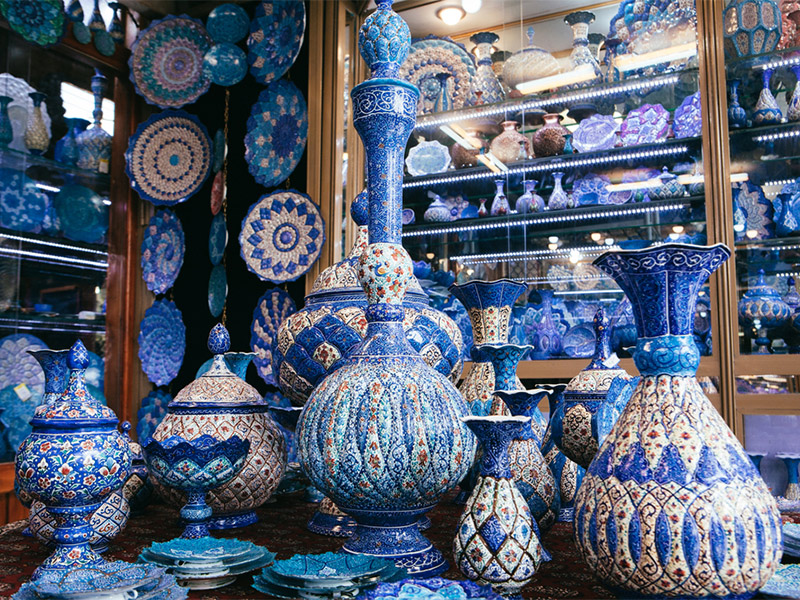
Introduction to traditional markets and shopping centers in Isfahan
The city of Isfahan is considered one of the major metropolises and tourist destinations of the country and, as a result, is home to various traditional markets and shopping centers.
Among the best bazaars and shopping centers in Isfahan are City Center Shopping Mall on Shahid Dastjerdi Highway, Jolfa Shopping Center on Khaghani Street, Martin Shopping Center at Hakim Nezami Square, Usan Shopping Center on Chahar Bagh Bala Street, Park Shopping Center on Chahar Bagh Bala Street, Orkideh Shopping Center on Hakim Nezami Street, Mehrsan Shopping Center on Bozorgmehr Street, Shahr Shopping Center on Chahar Bagh Abbasi Street, Kowsar Shopping Center on Chahar Bagh Bala Street, Hakim Grand Bazaar on Hakim Street, Honar Bazaar on Chahar Bagh Abbasi Street, Qeisariyeh Bazaar on Hakim Street, Isfahan Grand Bazaar at Imam Ali Square, Naghsh-e Jahan Bazaar at Naghsh-e Jahan Square, Isfahan Mobile Bazaar at the beginning of Ferdowsi Street, Flower and Plant Bazaar on Hamedaniyan Street, and Persian Gulf Fish Market on Safa Boulevard.
Where are the coziest cafes in Isfahan and Isfahan’s traditional sharbat houses?
Isfahan City offers a wide range of amenities and recreational facilities, and one of the most popular ones is the presence of cozy cafes and traditional sharbat houses. People of Isfahan and tourists visit these places to enjoy cold and hot beverages, various desserts, and delicious snacks.
Some of the most famous cafes and sharbat houses in Isfahan include Firouz Sharbat House in the Jolfa neighborhood, Roozegar Sharbat House in Naghsh-e Jahan Square, Bahar Narenj Sharbat House on Hakim-e Nezami Street, Haj Mirza Coffeehouse in Naghsh-e Jahan Square, Radio Cafe on Chahar Bagh Abbasi Street, Any Cafe at the intersection of Jolfa and Corner of Vanak Church, Musio Arakel Historic House on Hakim-e Nezami Street, Bam-e Shahr Rooftop Restaurant Cafe in Hezar Jarib, and Kando Cafe on Chahar Bagh Abbasi Street.
Travel Guide to Isfahan – Introduction to Isfahan’s Tourist Neighborhoods
Jolfa Neighborhood:
Jolfa neighborhood is one of the most unique and oldest neighborhoods in Isfahan, dating back to the Safavid era. We highly recommend visiting this neighborhood during your trip to Isfahan. The presence of churches such as Vank Church, Saint George Church, Holy Mary Church, Sarkis Church, and Beit Lahm Church, along with cozy and attractive cafes and cobblestone streets, has made this neighborhood very popular among tourists.
Related post
Dancing Minarets in Menar jonban, Isfahan
Famous and Historical Churches of Isfahan
Mardavij Neighborhood:
Mardavij neighborhood is one of the historical neighborhoods of Isfahan, extending from Shiraz Gate to the Freiburg intersection. It is considered one of the tourist neighborhoods of Isfahan due to the presence of the Kabutar Tower, a commercial complex, a park, and various cafes and restaurants.
Mehrabad Neighborhood:
Mehrabad neighborhood is an old neighborhood located next to the Zayandehrud River. It is one of the affluent neighborhoods of Isfahan, close to tourist areas, and known as one of the most expensive neighborhoods in the city due to its amenities.
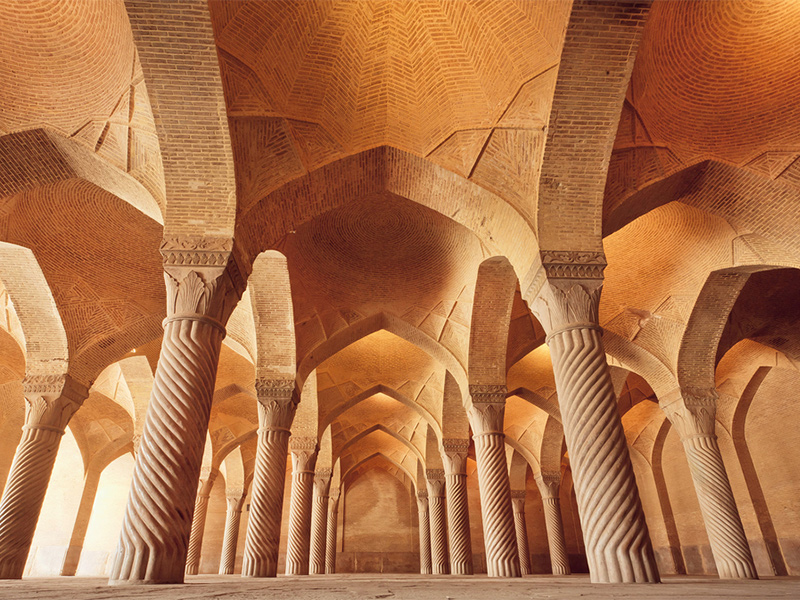
Abbasabad Neighborhood:
Abbasabad neighborhood belongs to the reign of Shah Abbas and is one of the old neighborhoods of Isfahan with many historical monuments such as Luqa Church and Kazeroni Mosque. This neighborhood is located in the northern part of the Zayandehrud River, between the Marnan Bridge and the Si-o-Se Pol Bridge. Due to its favorable location and easy access, it is considered one of the historical and convenient neighborhoods of Isfahan.
Chahar Bagh Bala Neighborhood:
Chahar Bagh Bala neighborhood, starting from the Si-o-Se Pol Bridge and ending at Shiraz Gate, is known as one of the expensive and touristy neighborhoods of Isfahan due to its convenient geographical location and easy access by metro and bus. It is also known for its cafes and restaurants, making it one of the bustling neighborhoods of Isfahan.
Why is Isfahan called “Half the World”?
From ancient times to the present day, Isfahan has been known as “Half the World.” The reason behind this title is the presence of over 6,000 historical monuments dating back hundreds and thousands of years, pristine natural areas, ancient relics from the pre-Christian era, valuable architecture of historical buildings, historical mosques and churches, and a high diversity of handicrafts. These factors have turned Isfahan into a city of history, art, and natural beauty, earning it the nickname “Half the World.”
Isfahan is the third most populous city in Iran after Tehran and Mashhad. Due to its rich history, it is considered one of the historical cities of the country. This city, located at the foothills of the Zagros Mountains, is one of the oldest cities in the country, dating back to the time of Tahmuras, the third king of the Pishdadian dynasty. Until the 6th century AD and before the arrival of Islam in Iran, Isfahan was the gathering place for soldiers from various regions of the country, including Bakhtiari, Khuzestan, Kerman, Sistan, and Sepahbodians. Later, during the Arsacid period, the main neighborhoods of Isfahan, namely Jey and Yahudiyeh, merged and formed the newly named Isfahan.
Most of the historical monuments in Isfahan are remnants from the Seljuk, Sasanian, and Safavid periods, each with its unique architecture in this city.
Summary of the Isfahan Travel Guide
The city of Isfahan is one of the important destinations in Iran for travel. It has gained international fame among domestic and international tourists due to its abundant attractions, unique architecture, suitable facilities, and rich culture, customs, and traditions. For history enthusiasts, Isfahan has become a significant destination, and without a doubt, travelers visit this beautiful city not just once but multiple times.
